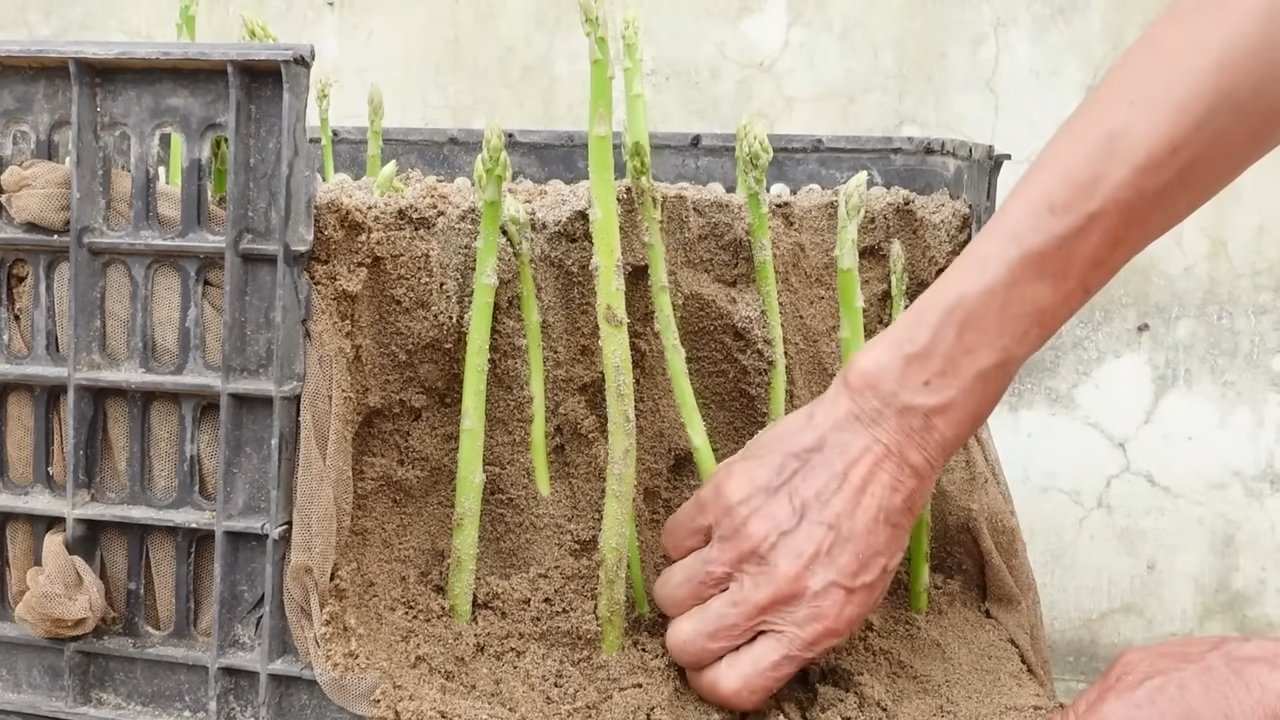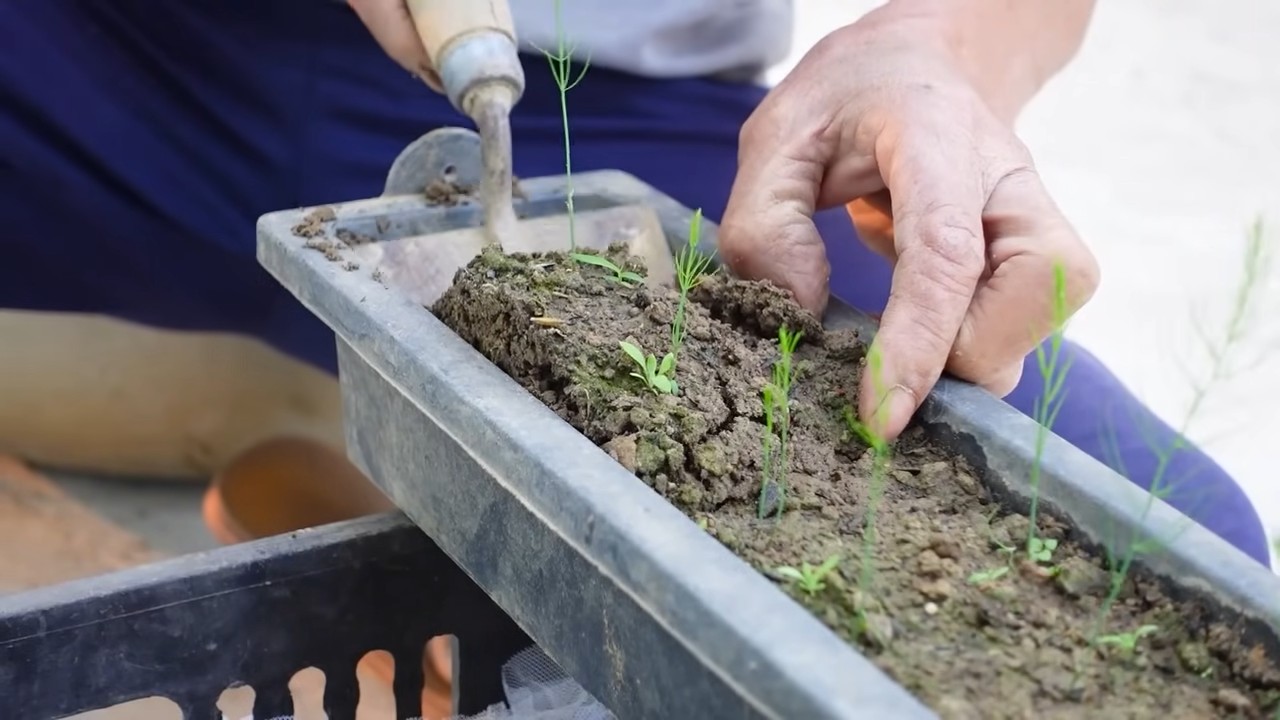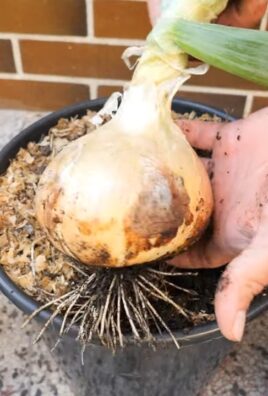Year Round Asparagus Harvest: Imagine stepping into your garden any time of the year and snipping fresh, vibrant asparagus spears for your dinner. Sounds like a dream, right? Well, it doesn’t have to be! For centuries, asparagus has been prized for its delicate flavor and nutritional benefits. From ancient Roman emperors who demanded it on their tables to modern-day foodies, asparagus has always held a special place in culinary history.
But what if I told you that you could extend your asparagus harvest far beyond the typical spring season? Many gardeners believe that a bountiful asparagus crop is limited to a few short weeks, but with a few clever DIY tricks and hacks, you can enjoy this delicious vegetable almost all year round.
This article is your ultimate guide to achieving a year round asparagus harvest. We’ll delve into simple, yet effective techniques that will help you maximize your yield and enjoy fresh asparagus whenever you crave it. Forget relying solely on grocery store produce; let’s unlock the secrets to a thriving, continuous asparagus harvest right in your own backyard! So, grab your gardening gloves, and let’s get started!

Year-Round Asparagus Harvest: A DIY Guide to Extended Growing Season
Hey there, fellow gardening enthusiasts! Are you tired of the fleeting asparagus season? Do you dream of enjoying those delicious spears for more than just a few weeks in the spring? Well, you’ve come to the right place! I’m going to share my secrets to extending your asparagus harvest and enjoying fresh spears almost year-round. It’s not magic, just a little bit of planning and some clever techniques.
Understanding Asparagus Growth
Before we dive into the how-to, let’s quickly touch on how asparagus grows. Asparagus is a perennial plant, meaning it lives for many years. It has an underground crown that sends up spears in the spring. These spears, if left unharvested, will fern out and produce energy for the plant to store in its roots for the next year’s growth. The key to extending the harvest lies in manipulating this growth cycle.
The Core Strategies for Extended Harvest
Here’s a breakdown of the main strategies we’ll be using:
* Succession Planting: Planting different varieties with varying maturity times.
* Delayed Harvesting: Allowing some plants to fern out early while harvesting others.
* Cold Frame/Greenhouse Protection: Extending the season at both ends with controlled environments.
* Forced Growth (Optional): A more advanced technique to stimulate off-season growth.
* Proper Care and Maintenance: Ensuring healthy plants for optimal production.
Choosing the Right Asparagus Varieties
Variety is the spice of life, and it’s also crucial for extending your asparagus harvest! Different varieties mature at different times, giving you a longer window of opportunity.
* Early Varieties: ‘Jersey Knight’ and ‘Millennium’ are known for their early production.
* Mid-Season Varieties: ‘Jersey Giant’ and ‘Purple Passion’ offer a good balance.
* Late Varieties: ‘Apollo’ tends to produce later in the season.
Planting a mix of these will naturally extend your harvest window. I recommend starting with at least two different varieties to see which performs best in your specific climate.
Step-by-Step Guide to Extending Your Asparagus Harvest
Alright, let’s get our hands dirty! Here’s the detailed guide to achieving that year-round asparagus dream.
1. Planning Your Asparagus Bed
* Location, Location, Location: Asparagus needs full sun (at least 6-8 hours per day) and well-drained soil. Choose a spot that won’t be disturbed, as asparagus can live for 15-20 years!
* Soil Preparation: Asparagus thrives in slightly acidic soil (pH 6.5-7.0). Amend your soil with plenty of compost and well-rotted manure. This will improve drainage and provide essential nutrients. I like to add a little bone meal as well for phosphorus, which promotes strong root growth.
* Bed Size: Plan for at least 3-4 feet between rows and 12-18 inches between plants within the row. This gives them plenty of room to grow and allows for easy harvesting.
2. Planting Asparagus Crowns
* Timing is Key: Plant asparagus crowns in early spring, as soon as the soil is workable.
* Digging the Trench: Dig a trench about 6-8 inches deep and 12 inches wide.
* Mounding the Soil: Create a small mound of soil in the center of the trench.
* Placing the Crowns: Place the asparagus crowns on top of the mounds, spreading the roots out like a spider.
* Covering the Crowns: Gently cover the crowns with 2-3 inches of soil. As the spears grow, gradually fill in the trench with soil until it’s level with the surrounding ground. This encourages strong root development.
* Watering Well: Water thoroughly after planting.
3. The First Two Years: Patience is a Virtue
This is the hardest part! Resist the urge to harvest any spears during the first two years. This allows the plants to establish a strong root system, which is crucial for long-term productivity.
* Weed Control: Keep the asparagus bed free of weeds. Weeds compete for nutrients and can stunt the growth of your asparagus.
* Watering: Water regularly, especially during dry periods. Asparagus needs consistent moisture to thrive.
* Fertilizing: Fertilize in early spring with a balanced fertilizer or compost tea.
* Fern Management: Allow the spears to fern out and grow tall. These ferns will photosynthesize and provide energy for the plant to store in its roots. In late fall or early winter, after the ferns have turned brown, cut them back to the ground.
4. Year Three and Beyond: Harvesting Begins!
Finally! You can start harvesting asparagus in the third year, but do so sparingly.
* Limited Harvest: Harvest for only 2-3 weeks in the spring. This allows the plants to continue building their root reserves.
* Harvesting Technique: Snap off the spears at ground level when they are about 6-8 inches tall.
* Continued Care: Continue to weed, water, and fertilize as needed.
5. Extending the Harvest: The Real Magic
Now for the fun part! Here’s how to extend your asparagus harvest beyond the typical spring season.
Delayed Harvesting
* Sacrifice Some Spears: In the spring, let some of your asparagus plants fern out early. This will stop spear production on those plants, but it will allow the other plants to continue producing.
* Rotating Sections: Divide your asparagus bed into sections. Harvest heavily from one section while allowing the others to fern out. Rotate the sections each year to give the plants a rest.
Cold Frame/Greenhouse Protection
This is where things get interesting! Using a cold frame or greenhouse can significantly extend your asparagus season at both ends.
* Early Start: In late winter or early spring, cover a section of your asparagus bed with a cold frame or greenhouse. This will warm the soil and stimulate early spear production.
* Late Harvest: In the fall, after the first frost, cover another section of your asparagus bed with a cold frame or greenhouse. This will protect the plants from the cold and allow you to harvest spears for a few more weeks.
* Ventilation: Remember to ventilate the cold frame or greenhouse on warm days to prevent overheating.
Forced Growth (Advanced Technique)
This technique involves digging up asparagus crowns in the fall and forcing them to grow indoors during the winter. It’s a bit more involved, but it can provide you with fresh asparagus spears in the dead of winter!
* Digging Up Crowns: In late fall, after the ferns have died back, carefully dig up some asparagus crowns. Choose healthy, mature crowns.
* Potting the Crowns: Pot the crowns in large containers filled with well-draining potting mix.
* Chilling Period: Place the pots in a cool, dark place (around 40°F) for 8-10 weeks. This chilling period is essential for breaking dormancy.
* Forcing Growth: After the chilling period, bring the pots indoors and place them in a warm, sunny location. Water regularly and fertilize with a balanced fertilizer.
* Harvesting: You should start to see spears emerging within a few weeks. Harvest the spears when they are about 6-8 inches tall.
* Replanting: After harvesting, you can replant the crowns in your asparagus bed in the spring. However, keep in mind that forced crowns may not be as productive as unforced crowns.
6. Year-Round Care and Maintenance
No matter which techniques you use, proper care and maintenance are essential for a healthy and productive asparagus bed.
* Weed Control: Keep the bed free of weeds.
* Watering: Water regularly, especially during dry periods.
* Fertilizing: Fertilize in early spring and again after the harvest with a balanced fertilizer or compost tea.
* Mulching: Apply a layer of mulch around the plants to help retain moisture, suppress weeds, and regulate soil temperature.
* Pest and Disease Control: Monitor your plants for pests and diseases. Asparagus beetles are a common pest. Handpick them or use an insecticidal soap.
* Crown Division (Every 5-7 Years): After several years, your asparagus crowns may become overcrowded. Divide the crowns in the fall to rejuvenate the plants and improve production.
Troubleshooting Common Asparagus Problems
Even with the best care, you might encounter some problems. Here are a few common issues and how to address them:
* Thin Spears: This can be caused by overcrowding, poor soil, or insufficient watering. Thin out the plants, amend the soil, and water regularly.
* Asparagus Beetles: These pests can damage the spears

Conclusion
So, there you have it! The secret to a year-round asparagus harvest is no longer a closely guarded secret. By embracing this simple yet effective DIY trick, you can bid farewell to fleeting asparagus seasons and welcome a continuous supply of this delicious and nutritious vegetable straight from your garden. Imagine the possibilities: fresh asparagus spears gracing your table in the depths of winter, adding a touch of spring to your holiday meals, and becoming a staple ingredient in your year-round culinary creations.
This isn’t just about extending the harvest; it’s about maximizing the potential of your asparagus patch and enjoying the fruits (or rather, vegetables) of your labor for a longer period. The initial investment of time and effort in setting up your cold frames or utilizing indoor growing techniques will pay dividends in the form of a consistent and abundant asparagus supply.
Don’t be afraid to experiment with variations to suit your specific climate and growing conditions. If you live in a particularly cold region, consider adding extra insulation to your cold frames or using grow lights to supplement natural sunlight during the darker months. For those in warmer climates, focus on providing adequate shade and moisture to prevent your asparagus from bolting prematurely.
Consider these variations to further enhance your year-round asparagus harvest:
* Succession Planting: Plant new asparagus crowns at different times of the year to stagger your harvests and ensure a continuous supply.
* Forced Asparagus: Try forcing asparagus indoors during the winter months for an extra-early harvest. This involves digging up mature crowns in the fall and replanting them in containers in a cool, dark location.
* Different Varieties: Explore different asparagus varieties that are known for their cold hardiness or heat tolerance to optimize your harvest in your specific climate.
* Companion Planting: Plant asparagus alongside companion plants like tomatoes, parsley, and basil to deter pests and improve soil health.
The beauty of this DIY trick lies in its adaptability. It’s not a one-size-fits-all solution, but rather a framework that you can customize to meet your individual needs and preferences. The key is to be observant, patient, and willing to learn from your experiences.
We wholeheartedly encourage you to give this DIY trick a try and experience the joy of a year-round asparagus harvest for yourself. It’s a rewarding and sustainable way to enjoy fresh, homegrown produce throughout the year.
Once you’ve implemented this technique, we’d love to hear about your experiences! Share your tips, tricks, and successes in the comments section below. Let’s create a community of asparagus enthusiasts who are passionate about extending the harvest and enjoying this delicious vegetable year-round. Your insights could be invaluable to other gardeners who are just starting out. So, get your hands dirty, embrace the challenge, and unlock the potential of your asparagus patch! Let’s all enjoy a bountiful and continuous **year-round asparagus harvest**!
Frequently Asked Questions (FAQ)
What is the best way to prepare my asparagus bed for year-round harvesting?
Preparing your asparagus bed properly is crucial for success. Start by choosing a sunny location with well-drained soil. Asparagus prefers a slightly acidic soil pH of around 6.5 to 7.0. Amend the soil with plenty of organic matter, such as compost or well-rotted manure, to improve drainage and fertility. When planting new crowns, dig trenches about 6-8 inches deep and space them 12-18 inches apart. Place the crowns in the trenches with the buds facing upwards and cover them with a few inches of soil. As the spears emerge, gradually fill in the trenches with soil. Consistent watering and fertilization are essential for healthy growth.
How do cold frames help extend the asparagus harvest?
Cold frames act as miniature greenhouses, trapping solar heat and protecting your asparagus plants from frost and freezing temperatures. This allows you to extend the growing season by several weeks or even months, depending on your climate. Construct a simple cold frame using wood, plastic sheeting, or glass. Position it over your asparagus bed in the fall to protect the plants from the first frosts. Vent the cold frame on warm days to prevent overheating. You can also use row covers or cloches to provide additional protection.
Can I grow asparagus indoors for a year-round harvest?
Yes, you can grow asparagus indoors, but it requires some effort and planning. Choose a dwarf asparagus variety that is well-suited for container growing. Use large containers with drainage holes and fill them with a well-draining potting mix. Provide plenty of sunlight or use grow lights to supplement natural light. Water regularly and fertilize every few weeks. You may need to hand-pollinate the flowers to ensure fruit production. Keep in mind that indoor-grown asparagus may not be as productive as outdoor-grown asparagus, but it can still provide a continuous supply of fresh spears.
What are some common pests and diseases that affect asparagus, and how can I control them?
Asparagus beetles are a common pest that can damage the spears and foliage. Handpicking the beetles or using insecticidal soap can help control them. Asparagus rust is a fungal disease that can cause orange or brown pustules on the stems and foliage. Improve air circulation and avoid overhead watering to prevent rust. Fusarium wilt is another fungal disease that can cause yellowing and wilting of the plants. Choose disease-resistant varieties and practice crop rotation to prevent wilt. Regularly inspect your plants for signs of pests or diseases and take action promptly to prevent them from spreading.
How often should I water and fertilize my asparagus plants for optimal growth?
Asparagus plants need consistent watering, especially during dry periods. Water deeply and regularly, ensuring that the soil is moist but not waterlogged. Fertilize your asparagus plants in the spring and fall with a balanced fertilizer that is high in phosphorus and potassium. You can also amend the soil with compost or well-rotted manure to provide additional nutrients. Avoid over-fertilizing, as this can lead to excessive foliage growth and reduced spear production.
How do I know when to harvest my asparagus spears?
Harvest asparagus spears when they are about 6-8 inches tall and about as thick as your finger. Use a sharp knife to cut the spears at ground level. Avoid harvesting all of the spears at once, as this can weaken the plants. Leave some spears to grow into ferns, which will help nourish the plants for the following year. The harvesting period typically lasts for 6-8 weeks in the spring. After the harvesting period, allow the ferns to grow and mature.
What should I do with my asparagus ferns in the fall?
In the fall, after the ferns have turned yellow or brown, cut them back to ground level. This will help prevent diseases and pests from overwintering in the ferns. You can also apply a layer of mulch to protect the crowns from freezing temperatures. In the spring, remove the mulch and fertilize the plants to encourage new growth.
Is it possible to force asparagus for an earlier harvest?
Yes, forcing asparagus is a technique that allows you to harvest spears earlier than usual. In the fall, dig up mature asparagus crowns and replant them in containers filled with potting mix. Place the containers in a cool, dark location with a temperature of around 50-60°F. Water regularly and wait for the spears to emerge. Once the spears are about 6-8 inches tall, you can harvest them. After the harvest, discard the crowns, as they will be exhausted.
What are some creative ways to use my year-round asparagus harvest?
The possibilities are endless! Enjoy your fresh asparagus spears grilled, roasted, steamed, or sautéed. Add them to salads, soups, omelets, and pasta dishes. Pickle them for a tangy snack or preserve them for later use. You can even use asparagus in desserts, such as asparagus ice cream or asparagus cake. Get creative and experiment with different recipes to discover your favorite ways to enjoy your year-round asparagus harvest.





Leave a Comment